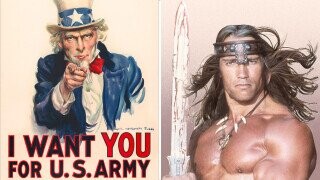5 Unexpected Things That Caused 'Dungeons & Dragons' To Exist

Hail adventurer! If you’ve come to this ancient, hallowed mountain top article seeking hidden knowledge, travel no further. Back in the 1970’s a man, nay, a legend named Gary Gygax created a table top role playing game called Dungeons & Dragons. Since then the game has changed and grown into a cultural juggernaut. There are hundreds of D&D Twitch streams, podcasts, even an animated show on Amazon Prime. The world and many of the characters (like Hobbits for example) were inspired by classic works of Western high fantasy, which were themselves inspired by the myths and legends from ancient Europe. The famous works of writers like J.R.R. Tolkien, Ursula K. LeGuin, and Jack Vance were all used (or ripped off depending on your perspective) to craft D&D. But other origins of the game are not so lofty. So today dear heroic reader, using our dark magics, we’ve stuffed 5 of the most unexpected inspirations Gygax used to craft the original game into this bag of holding listicle. Soldier on brave one, for knowledge is the greatest weapon of all.

New Line
The United States Army
Dungeons & Dragons was by no means the first role-playing strategy game. Many of the early predecessors to the game that inspired Stranger Things, weren’t fantasy games at all. They were usually military games, sometimes based off of real battle scenarios. One game, Strategos, was actually developed as a training tool for the actual, honest to god United States Army all the way back in 1880. Almost 100 years later, the game had made its way into the hands of some teenagers in Minnesota. Dave Arneson was a member of the Midwest Military Simulation Association, a wargaming group in the St. Paul area. He got introduced to the game and then in turn introduced it to, you guessed it, Gary Gygax. The two used the wargame as a jumping off point for crafting rules and stats for the game they would develop together, D&D.
Conan the Barbarian
Robert E. Howard is the creator of Conan the Barbarian, the hyper masc desert daddy now best known as either a hulking hero or a failed Arnold Schwartzenegger movie. The stories about Conan’s exploits were popular fiction while Gygax was growing up, and the hard hitting barbarian certainly seems like a character perfect for D&D. Howard is considered the progenitor of the “sword and sorcery” genre, which highly influenced Gygax and Arneson during the game’s development. Older fantasy books didn’t focus too much on combat, the magic was often subtle and very mysterious, and women were often objects of purity kept at arm's reach. Conan got into brutal combat, the magic in the world was flashy, and damsels in distress were ripe for romance. It was a paradigm shift for the genre, so the next time you seduce an NPC or brutally decapitate a goblin, remember you’ve got Conan to thank.
Ultraman
Gygax and his fellow game designers working on Dungeons & Dragons knew that one of the most important parts of any game is the enemies. Who and what you’re fighting coupled with how and why they fight back is a huge part of world building. It also creates the mathematical backbone of the game’s rules. Different enemies will have different amounts of hit points, armor classes, and attack roles. Seems simple enough to come up with monsters right? Well, the game was originally crafted with miniature figurines being an essential piece. But Gygax and the team making D&D were pretty small potatoes, they didn’t have the resources to create custom minis. So when it came time to craft the stats for the monsters, Gygax used a bag of random looking plastic toys he’d stumbled across in a store. The monsters were labeled as dinosaurs but were clearly knock off kaiju inspired by Japanese shows at the time, like the ultra popular Ultraman.

Netflix
The Bible
Despite the “Satanic Panic” hullabaloo of the 80’s, Dungeons & Dragons actually draws a lot of inspiration from the big wizard in the sky’s memoir, aka the Bible. God’s diary is all over D&D, from the plane of Gehenna, inspired by the name for the valley surrounding Jerusalem, to the devil Baalzebul, a rip-off of a biblical baddie. The spell Blade Barrier is even inspired by a certain flaming sword mentioned in the Bible.
His Daughter
During the game’s early development, Gygax and Arneson had mostly referred to it as “The Fantasy Game.” That’s not a great title as it does nothing to evoke the atmosphere of the epic world they were creating. It had, as the kids say, absolutely no vibe. So Gygax presented a list of names to his family. And as a famous space wizard once said, “wonderful the mind of a child is.” Gygax’s two year old daughter Cindy loved the name “Dungeons & Dragons.” The name stuck and now we’ve got an awesome title for an awesome game. Cindy also appears in another part of the D&D universe: the elven demi-god of music and magical songs is named Ye’Cind, named after the precocious youngster.
If you read this far, check out these other RPGs that are even better than D&D.